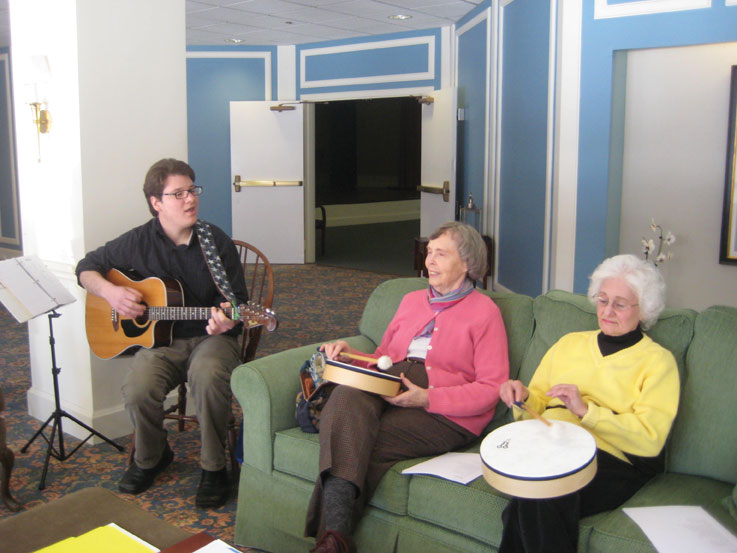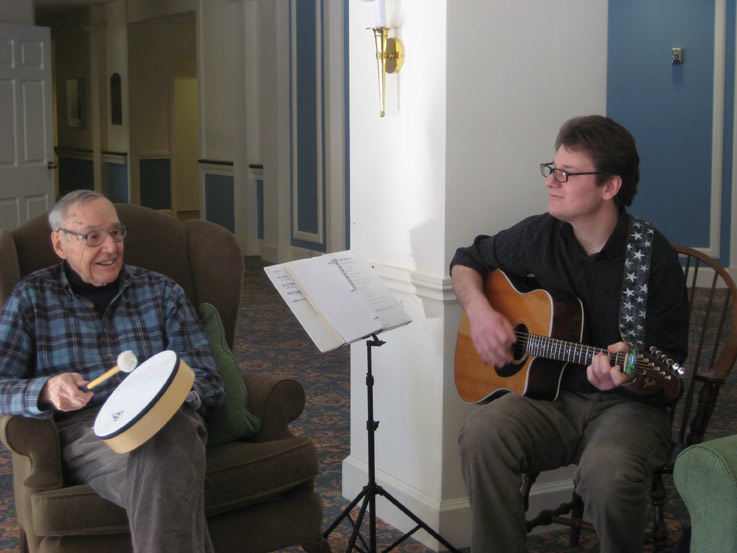Music Therapy Hums In SNFs & Assisted Living
Providers have recognized the benefits of music therapy and incorporated it into daily life.
Heather Clinger and Andrea Obston
3/1/2011
The idea of music as a healing influence that could affect health and behavior is as least as old as the writings of Aristotle and Plato, according to the American Music Therapy Association.
As described on the organization’s website, www.musictherapy.org, the modern version of music therapy began after World Wars I and II when amateur and professional community musicians visited veterans’ hospitals around the country to play for the thousands of patients who had suffered both physical and emotional trauma from the wars. After seeing notable physical and emotional responses to music, the hospitals began hiring musicians to play for patients. Click
HERE for an explanation of music therapy.
Fast forward to the 21st century, and people of all ages are benefiting from music therapy. Long term care providers have recognized the soothing and therapeutic benefits of music and adopted programs as part of their wellness, activity, or caregiving programs.
According to the Institute for Music and Neurologic Therapy (IMNT), the majority of research over the past 40 years has focused on music perception and performance, while basic science today continues to produce promising new information about the neuro-scientific effects of music.

In addition, numerous universities and clinical sites in the United States and Canada are currently involved in music and brain function research. Researchers and clinicians maintain that if specific responses to music can be mapped and then linked to what is needed by patients to accelerate their healing, they will find new ways to apply music prescriptively to hasten recovery. IMNT believes that such research has enormous possibilities for millions of people with impairments throughout the world.
A Therapy Tool
A continuing care retirement community in Bloomfield, Conn., has taken music therapy to a new level by using it as both a wellness and therapy tool. Duncaster Retirement Community’s innovative program was made possible through a $10,000 grant from a local foundation.
In the dedication ceremony for the Music Enrichment Program, guest speaker Emily Pellegrino, a board-certified music therapist and co-director of Connecticut Music Therapy Services, explained that music therapy can have wide-ranging benefits for older adults, including stress reduction, pain management, and building social intimacy and community. People don’t need to have any musical ability to benefit from this type of therapy, according to Pellegrino.
One of the most powerful things music does is to bring up memories, and music will trigger memory recall. People don’t even have to sing along for that to happen. They will just listen and a piece of music will evoke memories and reminiscences.
In a recent music therapy session, Pellegrino played the old classic, “You Are My Sunshine,” triggering a variety of memories from those in the program, which ranged from: “That’s what we sang around the campfire” and “I remember my father singing to my mother” to “That reminds me of my first date with my husband.”
Residents ended up discussing what they felt in ways that they might not have been comfortable sharing had the music not brought them together like that. Music becomes a bridge; a commonality that allows people to open up to each other.
Guitars, Drums, And Shakers
The people involved in Duncaster’s innovative music program also marvel at how music reconnects older people to their whole lives, not just their current ages.
Many noticed that a song can take residents back to that place where they were when they heard it; it connects residents to their whole self, their whole life.
The program has also brought residents closer together by promoting a sense of emotional well-being, especially if people participate with it on some level.

A significant portion of the residents’ association budget is allocated for music-related programs, including orchestras, pianists, big band, swing, and a cappella groups. At Caleb Hitchcock, Duncaster’s long term care facility, four to six music programs are offered each week, including music education, sing-a-longs, and music trivia.
One of Duncaster’s music therapists will start a session off with a guitar and then encourage people in the program to jump in with drums or shakers. They may come into that session without knowing the other people in the group, but by the end they will have a connection. This musical experience becomes the common element that brings them together, even if they didn’t start out knowing each other when they walked into the room.
The program will allow for greater frequency and more diverse hands-on and listening music experiences and will soon include a hand-chime choir, drum circle, and harp therapy. It is anticipated that 20 to 24 residents will take part in the hand chime choir, eventually performing for residents, family, and staff. Participation in both the choir and the drum circles will be open to anyone regardless of knowledge or ability.
Many of the drums are hand-held or can be placed on the floor in front of participants for ease of use. Participatory drumming has been shown to have positive benefits, including increased socialization, an increase in circulation, and stress relief. In addition, Duncaster will host appearances by a musical ensemble from the Hartford Symphony Orchestra.
Duncaster’s Music Enrichment Program is the only one of its kind in the area and expands on the retirement community’s long history of music programming.
Click
HERE to find more resources on starting a music therapy program.
Click
HERE for information about one person's mission to get iPods into every facility.
Heather Clinger, MPH, is Duncaster's director of wellness. Andrea Obston is president of Andrea Obston Marketing Communications. She can be reached at aobston@aomc.com.